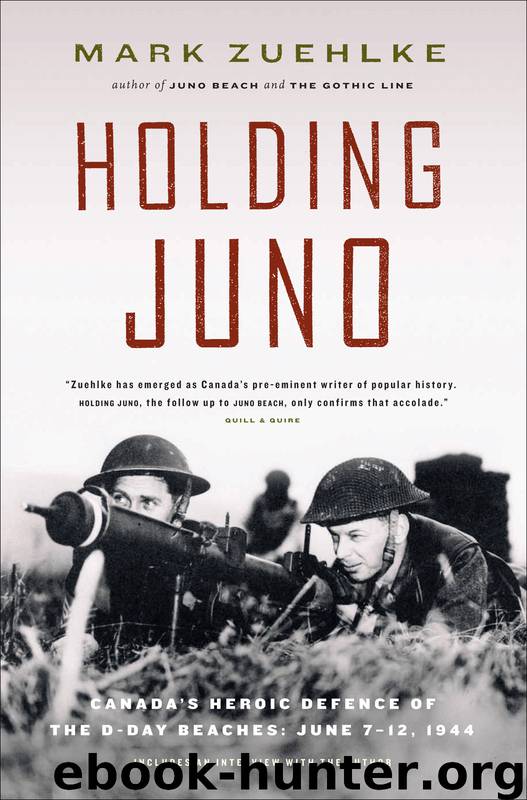Holding Juno by Mark Zuehlke

Author:Mark Zuehlke [Zuehlke, Mark]
Language: eng
Format: epub
Tags: HIS027100
Publisher: Douglas & McIntyre
Published: 2006-03-24T16:00:00+00:00
[ 14 ]
With Rage and Sorrow
BLOODY TOIL was the order of the day for both the Germans and Allies on June 9, with neither able to gain significant advantage or to wrest control of essential ground from the other. Late the previous day, General Bernard Montgomery had realized that continuing to attempt seizing Caen with frontal attacks was futile. Despite his dislike for altering offensive plans midcourse, there was no alternative. Having established a tactical headquarters for himself in Creully’s ancient castle, Montgomery pondered maps and considered the dispositions of units. “I have decided not to have a lot of casualties by butting up against the place,” he then announced. “So I have ordered Second Army to keep up a good pressure [in front of Caen] and to make its main effort toward Villers-Bocage and Evrecy, and thence southeast toward Falaise.”1
This shifted the impetus of operations from directly north of Caen, where 3rd British Infantry Division and 3rd Canadian Infantry Division had originally been tasked with battering their way head-on into the city, in favour of a flanking attack. Too cautious and shrewd a tactician to believe a single southeast hook could necessarily reach Caen, he decided to simultaneously pass the 51st Highland Division through 6th Airborne Division’s lines east of the River Orne to strike the city from that flank. These two pincers would encircle the city, and when their dagger-like leading edges met, any enemy within the city and environs would be trapped. To ensure that the Germans were prevented from taking flight before the pincers closed on the Falaise plain, Montgomery intended to drop the 1st British Airborne Division in the Odon valley at Noyers and Evrecy to block the obvious escape route.
Montgomery knew he was in a race with his nemesis Generalfeldmarschall Erwin Rommel to develop an offensive plan and be first out of the gate, for surely the German commander was doing precisely the same thing. “If the Germans wish to be offensive and drive in our lodgement area between Caen and Bayeux, the best way to defeat them is to be offensive ourselves and the plan will checkmate the enemy completely if we can pull it off,” he said.2
The biggest threat to success was the necessary delay before his operation could begin. Although the 7th Armoured Division—tasked with executing the right hook—had landed on D+1, the left-hook force of the 51st Highland Division and supporting 4th Armoured Brigade were still straggling ashore. Landings since D+1 had been severely hampered by the continually worsening maritime conditions created by a series of storm tracks. Montgomery complained that the “bad weather is a great nuisance as what we want now is to be able to take quick advantage of our good position by striking deep before the enemy can build up strength against us.”3 Despite these problems, he hoped to kick off the offensive on June 10.
No sooner was his plan formulated than Allied Expeditionary Air Force commander Air Marshal Sir Trafford Leigh-Mallory scotched the airborne drop, scheduled for daylight to avoid the chaos that had plagued the D-Day landings.
Download
This site does not store any files on its server. We only index and link to content provided by other sites. Please contact the content providers to delete copyright contents if any and email us, we'll remove relevant links or contents immediately.
| 19th Century | 20th Century |
| Exploration | First Nations |
| Founding | Pre-Confederation |
| Province & Local | War of 1812 |
Cat's cradle by Kurt Vonnegut(15189)
Pimp by Iceberg Slim(14398)
4 3 2 1: A Novel by Paul Auster(12289)
Underground: A Human History of the Worlds Beneath Our Feet by Will Hunt(12027)
The Radium Girls by Kate Moore(11930)
Wiseguy by Nicholas Pileggi(5674)
Perfect Rhythm by Jae(5326)
American History Stories, Volume III (Yesterday's Classics) by Pratt Mara L(5257)
The Fire Next Time by James Baldwin(5251)
Paper Towns by Green John(5092)
Pale Blue Dot by Carl Sagan(4915)
A Higher Loyalty: Truth, Lies, and Leadership by James Comey(4851)
The Mayflower and the Pilgrims' New World by Nathaniel Philbrick(4428)
The Doomsday Machine by Daniel Ellsberg(4420)
Killers of the Flower Moon: The Osage Murders and the Birth of the FBI by David Grann(4387)
The Sympathizer by Viet Thanh Nguyen(4307)
Too Much and Not the Mood by Durga Chew-Bose(4278)
The Borden Murders by Sarah Miller(4251)
Sticky Fingers by Joe Hagan(4105)
